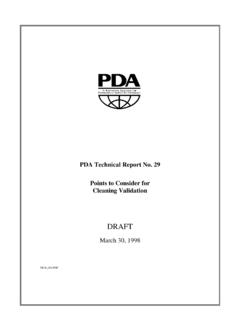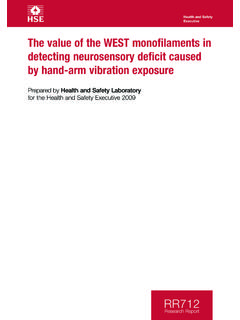Transcription of QUANTITATIVE BUFFY COAT (QBC) TEST AND OTHER …
1 NATIONAL JOURNAL OF medical RESEARCH print ISSN: 2249 4995 eISSN: 2277 8810 Volume 2 Issue 3 July Sept 2012 Page 386 REVIEW QUANTITATIVE BUFFY coat (QBC) TEST AND OTHER DIAGNOSTIC TECHNIQUES FOR DIAGNOSING MALARIA: REVIEW OF LITERATURE Vaidya Kuladeepa A1, Sukesh2 1 Assistant Professor, 2 Associate Professor, Department of Pathology, SIMS &RC, Surathkal, Karnataka Correspondence: Dr. Kuladeepa Ananda Vaidya, Email: ABSTRACT The technical capability to perform a correct and timely diagnosis of malaria infection in an ill patient is of critical importance since symptoms of complicated malaria may suddenly develop, leading to death of the patient.
2 Even though peripheral blood smear examination is considered as the gold standard technique, tests like QUANTITATIVE BUFFY coat (QBC) test and Rapid diagnostic tests (RDTs) are widely used and more sensitive in detecting malaria parasite. Here we are briefly highlighting the importance of QBC and OTHER useful diagnostic methods for diagnosing malaria. Key words: QUANTITATIVE BUFFY coat , Malaria, Diagnosis, Peripheral blood smear INTRODUCTION The demonstration of malarial parasite is a requisite for definitive diagnosis of malaria. The conventional method used for the diagnosis is the thick and thin smears.
3 This method costs less and easy to handle but on the OTHER hand, it has several disadvantages 1. Rapid diagnosis of malaria is pre-requisite for effective treatment and reducing mortality and morbidity of malaria. The QBC method has its advantages in terms of speed, sensitivity and ease, especially in an endemic area. Although QBC method is superior to the smear for malarial parasite detection, species identification is difficult in this DISCUSSION: While looking for malarial parasite in pheripheral smears, blood smears should be repeated every 12-24 hours for a total of 3 sets.
4 If all 3 are negative, the diagnosis of malaria can be essentially ruled out 3. QBC tube method has higher sensitivity and greater rapidity compared to Leishman stained thick and thin blood films in detecting malarial parasite 4. There are many laboratory methods of diagnosing malaria, few are briefly discussed below. BUNCH OF DIAGNOSTIC TOOLS a) Microscopic examination of thick and thin smears Conventional light microscopy is the established gold standard for the confirmation of malaria. Microscopy requires trained, skilled technicians, good supervisory personnel and good equipment (microscopes, reagents) in order to achieve gold standard sensitivities and specificities.
5 5. Microscopy can be used to quantify and characterize species and circulating stage, providing indices to guide therapy. Unlike OTHER diagnostic modalities, microscopy provides a permanent record of results. Unfortunately, microscopy can be time-consuming (requiring at least 60 minutes from time of sample collection to diagnosis), and clinicians may make treatment decisions without the benefit of the False positive results - Poor blood film preparation generates artefacts commonly mistaken for malaria parasites, including bacteria, fungi, stain precipitation, and dirt and cell debris.
6 Normal blood components such as platelets also confound diagnosis. Improved training and higher quality of smear preparation and staining are required to reduce false positive False negative results. The chance of false negative results increases with decreasing parasite densities 7,8,9. Greater microscopist s experience, increased examination time and number of microscopic fields examined reduces such an Recommended numbers of fields on a thick blood film required for examination before declaring a slide negative vary from 100 400. 7,11,12 b) Polymerase chain reaction NATIONAL JOURNAL OF medical RESEARCH print ISSN: 2249 4995 eISSN: 2277 8810 Volume 2 Issue 3 July Sept 2012 Page 387 Analysis of blood samples by amplification of parasite-specific nucleic acids by nested and real-time polymerase chain reaction (PCR) is reported to be highly sensitive and specific.
7 The technique requires highly trained personnel, and is both time and Nested PCR is valuable as a confirmatory test and implementation should be considered by reference laboratories and with adequate laboratory infrastructure to perform molecular procedures 13 c) Rapid diagnostic test- Immunochroma-tographic method Rapid diagnostic tests (RDTs) use immunochroma-tographic methods to detect antigens derived from malaria parasites in lysed blood. tests that are currently available rely on detection of the substances like Histidine-rich protein II, Parasite lactate dehydrogenase (pLDH).
8 Histidine-rich protein II (HRP-II) 14 a water-soluble protein produced by trophozoites and young gametocytes of P. falciparum only; Parasite lactate dehydrogenase (pLDH) produced by asexual and sexual stages (gametocytes) of parasites of P. falciparum and non-falciparum species. RDTs have generally been reported to achieve sensitivities of > 90% in the detection of P. falciparum at densities at or above 100 parasites/ l of blood. Below this level, sensitivity decreases markedly. Since RDTs detect circulating antigens, they may detect infection with P.
9 Falciparum even when the parasites are sequestered deep in the vascular compartment and thus undetectable by microscopic examination of a peripheral blood smear. Among the advantages of RDTs are their ease of use and interpretation. They do not require any electricity or special equipment. 15. d) QUANTITATIVE BUFFY coat (QBC) technique The speed of QBC method (15 min) in detecting malarial parasites is a definite advantage in laboratories which screen large number of samples. In addition, low levels of parasitaemia (2 parasites/ l) can easily be detected as more blood is being used per sample (55-65 l).
10 There is no loss of parasites during the procedure. The parasitized erythrocytes are concentrated in the small area of BUFFY coat , which helps in rapid scanning of the parasite. Another advantage of QBC is its ease of interpretation and it being technically easy to perform 2. Diagnosis of malaria by the acridine orange staining of centrifuged parasites in microhematocrite tubes is easy to learn 16. A technician can be taught to carry out the QBC test and detect malarial parasite accurately, in less than a day, in contrast to smear examination and interpretation which takes weeks.






